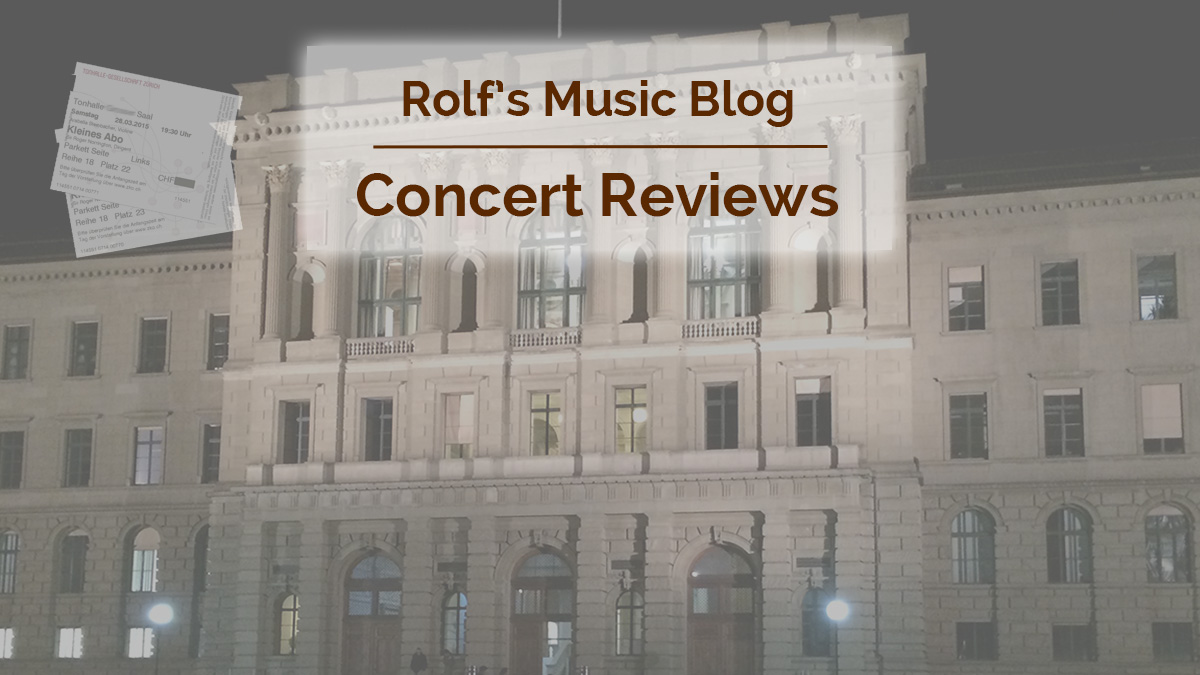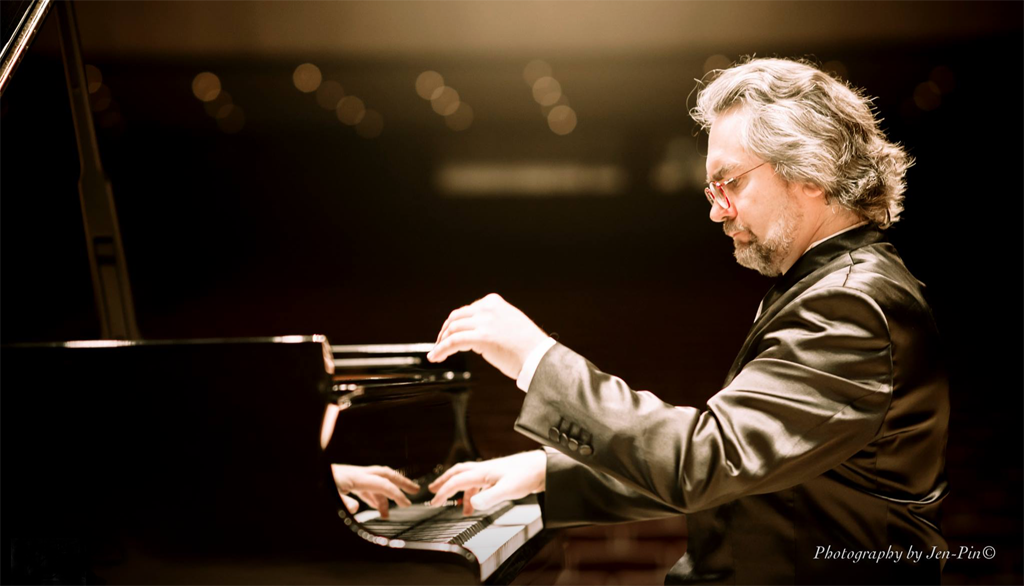Piano Recital: Konstantin Scherbakov
Works & Transcriptions by Leopold Godowsky
Semper-Aula, ETH Zurich, 2016-04-19

2016-04-24 — Original posting
2016-10-11 — Brushed up for better readability
Table of Contents
- Introduction
- Leopold Godowsky (1870 – 1938)
- Transcription of J.S. Bach’s Cello Suite No.2
- Transcription of Lieder by Franz Schubert
- 3 Pieces from the “Java” Suite
- 6 Pieces from “Triakontameron”
- Transcription of “Ständchen” by Richard Strauss
- Transcription of “Triana” from “Iberia” by Isaac Albéniz
- Symphonic Metamorphose on “Wein, Weib und Gesang” by Johann Strauss II
- Conclusions
- Encores
- Addendum 1: CD Recordings
- Addendum 2
Introduction
This was not my first encounter with the Russian pianist Konstantin Scherbakov (Константин Александрович Щербаков, *1983 in Barnaul, Siberia): see my review from the concert in the Zurich Tonhalle on 2015-12-12 and references therein. However, it’s the first time I heard him in concert with music by Leopold Godowsky (1870 – 1938), one of his favorite composers. In fact, he is about to complete his project of recording all of Godowsky’s works for piano solo. So far, he has recorded 13 CDs, just two more are missing: Godowsky’s famed (if not notorious?) 53 Studies on Études by Frédéric Chopin. I’m really looking forward to this recording!
Leopold Godowsky (1870 – 1938)
This recital was an opportunity to look back (in excerpts) onto the Godowsky recordings the artist has recorded so far. The concert was announced as “The Pianist’s Pianist“. With that title, the organizers referred to Leopold Godowsky’s role as a cornerstone pianist. He was an exemplary figure for the entire period since the piano was invented, or at least since the times of Chopin and Liszt.
Godowsky was known as master in the development of keyboard technique. Still, he was barely known as piano virtuoso on the concert stage. Very few of his original piano compositions have been or are being played in concert. But still, he was a brilliant pianist who firmly believed in the possibility of further developing piano technique (almost) without limitations.
The existing piano repertoire did not appear to suffice for that (self-imposed) task, and so, Godowsky set off to create his own repertoire. He did so with original compositions, but primarily by adopting (transcribing, paraphrasing) existing pieces by baroque up to contemporary composers. As composer, he was most successful with such adaptations, transcriptions and paraphrases. It’s as if Godowsky’s fantasy / imagination needed (or was boosted by) existing compositions as a starter. Among his original works, I think the most successful ones are small forms, mostly pieces of a few minutes duration. He did write one fairly big, but rarely played piano sonata. This recital gave an excellent overview over both his transcriptions, as well as small-form, original compositions.
Transcriptions
First, a clarification: in the pieces that are based on works by other composers, the term “transcription” does not have the same meaning as a typical transcription in baroque and classical time. There, it typically implied a mere transfer onto a different (set of) instrument(s), with adjustments as mandated by the difference in the instrument (e.g., a narrower tonal range forcing octave shifts, etc.).
Godowsky takes this much further, e.g., by adding new voices (often with complementary rhythms), “filling” harmonies, even adding entirely new / different “Godowsky style” harmonies, i.,e., a style which I find to be close to that of Sergei Rachmaninoff and Nikolai Medtner. Overall, the result is often a dense web of voices and rhythms (and harmonies, if you want).
Typically, the original musical substance is still present in Godowsky’s transcriptions, although sometimes almost buried in the added material. Godowsky takes this a step further in his Studies on the Chopin Études (which I discussed in an earlier post): here, he often strips an Étude down to a mere skeleton, then adding new voices (or even a second Étude!). But in that case, he uses the term “study” rather than “transcription”.
With the exception of the encores, all works in this program were compositions or transcriptions (see above) by Leopold Godowsky. I may not mention this with every piece.
Transcription of J.S. Bach’s Cello Suite No.2
Original and Transcription
Konstantin Scherbakov opened his program with the transcription of the Cello Suite No.2 in D minor, BWV 1008, by Johann Sebastian Bach (1685 – 1750), which follows the scheme of a typical baroque suite:
- Prélude (3/4)
- Allemande (4/4)
- Courante (3/4)
- Sarabande (3/4)
- Menuet I (3/4)—Menuet II (3/4)—Menuet I
- Gigue (3/8)
Among Bach’s suites for cello solo, the original Suite in D minor is a relative austere piece, different in atmosphere especially from the four suites in major tonalities. It is mostly written for a single voice (polyphony is hard to realize on a cello). It’s absolutely amazing to see what change this music is undergoing in Godowsky’s “transcription”! Pretty much throughout the suite, the melody line is romantically (re-)harmonized, i.e., largely reinterpreted harmonically, while at the same time complementary voices are added / invented. The melody line remains mostly intact (apart from some octave shifts), though occasionally it is hiding in Godowsky’s polyphonic textures.
The Performance
I. Prélude
The result is mostly quite far from Bach’s original. This is clear from the introductory, pulsating bass notes in the Prélude which are not found in Bach’s score. Already these bass notes seemed so rich, full-sounding in this small venue, capturing the listener’s attention. Where one expected to hear Bach’s single-voice melody line, we were confronted not only with the full, warm sound of the Steinway D concert grand, but also immediately with the rich, harmonic setting in Godowsky’s transcription (through all movements), with its long dynamic arches and build-ups, powerful sound and harmony. The transcribed movement ends by repeating the introductory, pulsating bass notes.
II. Allemande
The Allemande, in baroque times a rather heavy (if not clumsy) dance movement, appears at a fluent pace, in the form of a polyphonic piece, a dialog between the two hands.
III. Courante
The Courante is an almost swinging, fast movement, retaining the dance character, again harmonized and with left-hand accompaniment, not only setting a rhythmic foundation, but also adding melodic counterpoints; the lightness in the tempo is somewhat compensated by density of the complex, polyphonic texture.
IV. Sarabande
To me, the Sarabande was the movement that remained closest to Bach’s original in character, despite the added harmonization.
V. Menuets I/II
The remaining dance movements are maybe less dance-like, certainly much heavier than the baroque originals, especially the first Menuet. The second Menuet, albeit much “larger” than the original in sound and attitude, is unfolding in utter harmonic and melodic beauty: very nice music, indeed. Already in Bach’s original, this is the one serene moment in the entire suite.
VI. Gigue
Also in the Gigue, Godowsky’s setting is much more massive (“moving a much larger machinery”), heavier, though it retains some dance character, with impressive dynamic buildups, and ending in mighty chord cascades.
Overall, it is really interesting, late-romantic music, alluding to the baroque original.
Transcription of Lieder by Franz Schubert
The next segment featured three transcriptions / paraphrases on Lieder by Franz Schubert (1797 – 1828):
- from the Lied cycle “Die schöne Müllerin“, op.25, D.795: 8. Morgengruß (“Guten Morgen, schöne Müllerin“). This transcription is much more than a “Lied ohne Worte” (a “song without words”, as propagated by Felix Mendelssohn Bartholdy). It is switching between melody fragments and sections that sound rather like a broad instrumental phantasy. Godowsky is not trying to reproduce Schubert’s song as such, but rather seeks to reproduce the mood, the basic character in Schubert’s Lied;
- from the same cycle, the well-known, introductory song “Das Wandern“: among the three Lied transcriptions, this feels closest to the original, retaining most of melody and accompaniment, even though the underlying accompaniment often appears to be doubled in voices and/or complexity. The transcription essentially covers the original, two-hand accompaniment in the left hand alone!
- Finally “Litanei“, based on the Lied “Litanei auf das Fest Allerseelen“, D.343: also here, Godowsky largely retains the character of the original. He leaves the focus on the melody line, mostly keeping the accompaniment in the left hand. The song builds up to an intense climax, which then leads into a solemn, calm ending.
3 Pieces from the “Java” Suite
The last segment prior to the intermission featured three pieces from Godowsky’s “Java” Suite. These are original works, a suite in four parts (each part featuring three pieces of 2 to 7 minutes duration). In this music, the composer digested his encounters and his fascination with the music of the Indonesian island of Java. He also called this “Phonoramas, tonal Journeys for piano”. Here’s how the pieces played (bold) fit into the Suite:
- Gamelan (1)
- Wayang-Purwa, Puppet Shadow Plays
- Hari Besaar, The Great Day
- Chattering Monkeys at the Sacred Lake of Wendit (3)
- Boro Buudur in Moonlight
- The Bromo Volcano and the Sand Sea at Daybreak
- Three Dances
- The Gardens of Buitenzorg (2)
- In the Streets of Old Batavia
- In the Kraton
- The Ruined Water Castle at Djokja
- A Court Pageant in Solo
How Does it Sound?
The spirit of the original Indonesian music (as I remember it) is well captured in these pieces (notably in the first one, “Gamelan“), even though it is of course veiled in late-romantic (“Medtner”-style) colors, especially in “The Gardens of Buitenzorg“. The mood in that latter piece also reminded my of the song “Von der Schönheit” from Gustav Mahler‘s “Lied von der Erde” (which, after all, is also referring to poems and music from the Far East!). The last piece played, “Chattering Monkeys at the Sacred Lake of Wendit“, is a real fun piece, very busy, indeed chattering with its tone repetitions. It was a smiling ending for the first part of this concert!
6 Pieces from “Triakontameron”
After the intermission, Konstantin Scherbakov continued his recital with six pieces from Godowsky’s “Triakontameron“, a collection with the subtitle “30 Moods and Scenes in Triple Measure” (the name “Triakontameron” was selected in analogy to Boccaccio’s “Il Decamerone“). It’s an illustrated journey through a wide range of cities, landscapes, scenes and cultures. These pieces are typically shorter than those in the “Java” Suite; the selection for this concert included the following pieces (in the order played):
The Pieces Played
- Nocturnal Tangier
A somber piece that reminded me of a slow Tango, maybe with allusions to Gamelan music (or was this just a reminiscence from what we heard before the intermission?) - Sylvan Tyrol
A light, joyful, swinging waltz (close to salon music in its mood?) - The Music-Box
A lovely miniature, depicting a little music box (maybe with dancing elves?), imitating the irregular, sometimes erratic movement of the clockwork in such devices. - The Salon
Here, we definitely found ourselves in the mood, the atmosphere of salon music, with a melancholic waltz. This is seemingly shallow in style, yet really artful, and likely not as easy to play as it sounds! - Quixotic Errantry
The title of this piece doesn’t require explaining: a swinging, sometimes noisy piece, with often dense, polyphonic texture, polyrhythmic—and technically demanding, virtuosic! - Alt Wien, “Whose yesterdays look backwards with a smile through tears”
A melancholic, forlorn waltz, as the title indicates.
I suspect that the technical demands in these pieces are easily underestimated!
Transcription of “Ständchen” by Richard Strauss
The song No.2, “Ständchen“ (Serenade), from “6 Lieder“, op.17 (TrV 149), by Richard Strauss (1864 – 1949) is such excellent music already in the original—simply brilliant! In Godowsky’s transcription, this formed a major contrast to the music that we heard before: all the pieces that followed are highly virtuosic, but this particular one turned out to be a real cabinet piece! It features an almost constantly running accompaniment of fast passagework running into and through broken chords, all supporting the melody line, which Konstantin Scherbakov managed to highlight through all the busy accompaniment. Throughout the short piece, Godowsky manages to retain the character, the atmosphere (and most of the typical harmonies) in Richard Strauss’ original song: a masterpiece in several ways!
Transcription of “Triana” from “Iberia” by Isaac Albéniz
Already in the original, the Suite “Iberia” by Isaac Albéniz (1860 – 1909) is a virtuosic challenge for the artist. From book 2 of this suite, Leopold Godowsky transcribed No.6, Triana. As expected, one finds a much denser, very virtuosic texture: almost throughout the piece one has the impression of two pianists / four hands playing, and yet, the transcriber managed to retain the atmosphere of Albéniz’ original!
Symphonic Metamorphose on “Wein, Weib und Gesang” by Johann Strauss II
The last piece in the official program was “Wein, Weib und Gesang“ (Wine, Woman, and Song), the No.3 from “3 Symphonic Metamorphoses on Themes of Johann Strauss II” (a.k.a. Johann Strauss, Sohn, 1825 – 1899). This “Metamorphose” is far more than a transcription: maybe a paraphrase, but really an original composition based on themes from the waltz op.333 by Johann Strauss II. It was the virtuosic culmination of the recital program: a multi-faceted composition, interchanging between Strauss’ joyful waltz theme and virtuosic outbreaks, growing to orchestral dimensions. It is a pianistic masterwork, exemplary for the composer’s style: Godowsky at his best! Despite the complexity of the score, Konstantin Scherbakov maintained clarity in his playing.
Conclusions
Difficulty & Complexity …
The technical difficulties in Godowsky’s piano works are hard to assess for “ordinary people” / non-virtuosos. As layperson, one is easily overwhelmed by the density, the polyphonic and polyrhythmic texture of his piano scores. Many pianists use this to highlight / emphasize their own abilities / virtuosity, in the sense of (talking about Godowsky’s 53 Studies on Études by Frédéric Chopin) “Chopin’s Études are already extremely demanding, but Godowsky makes them vastly more difficult in his Studies”.
Interestingly, Konstantin Scherbakov stated in an interview that “Once learned, Godowsky’s Studies are actually easier to play than Chopin’s original Études” [this quote is not literal]. For a non-virtuoso, this is hard to verify, be it only because Konstantin Scherbakov’s recording of these 53 Studies is not available yet (and because so far he has not recorded Chopin’s Études). However, it certainly is an interesting statement that may shed a dubious light onto other artists!
… And Mastering Them
One may find that claim confirmed insofar, as Scherbakov’s demeanor is devoid of stardom. His posture stayed relaxed throughout the recital, arms and hands remain without any tension at all times. The fingers remain on or close to the keys, his facial expression is concentrated, focused, but neutral, calm. Nothing like the grimacing faces that we remember from other artists! If one pictures ignoring the music and just watching his hands, one might even think of watching a bar or salon pianist play or improvise! Visually, Scherbakov’s playing appears so light, if not simple, almost casual—be it only because his playing comes almost entirely out of his fingers.
However, there could barely be a bigger difference between the visual impression and music that emerges from the instrument. Konstantin Scherbakov is a master of touch, of differentiated dynamics, and he knows very well how to adjust his playing to the instrument and to the acoustics of the venue. Seemingly without physical effort he is able to generate vast masses of sound from the concert grand. Yet, he manages to keep the sound clear and transparent. At the same time, he avoids an excess of romanticism. Throughout the recital, I didn’t note a single insecurity. It was a thoroughly consistent and impressive performance.
I should also state that the selection of the pieces for this recital, and their arrangement / sequence was excellent. Both halves of the program formed logical progressions / dramatic evolutions that made sense and felt compelling: well done!
Encores
At the end of this program I was tempted to re-interpret the meaning of the title / motto of the recital: in Konstantin Scherbakov, Godowsky as model pianist has found an ideal artist for his works—The Pianist’s (Godowsky’s) Pianist …
Really only during the final applause one could gather that this program (especially of course the last three works) was physically demanding on the artist. That did not stop the pianist from playing two encores from the five Morceaux de fantaisie, op.3, by Sergei Rachmaninoff (1873 – 1943):
- 5. Serenade in B♭ minor
- 4. Polichinelle in F♯ minor
They are not by Godowsk.y Nevertherless, these two pieces were fitting very well, and anbd an excellent conclusion to the recital, both in style and in atmosphere. Particularly “Polichinelle” is highly virtuosic, and—the one disadvantage of these encores—both also demonstrated that Rachmaninoff as inventive / imaginative composer was clearly superior to Godowsky.
Addendum 1: CD Recordings
As mentioned, Konstantin Scherbakov is about to finish his project of recording all of Godowsky’s solo works for piano. The CDs below cover the pieces played in this concert. Note that at this point I do not have all these CDs in my collection. However, I have enough experience with this artist, both from concerts and recordings, to recommend them nonetheless.
Remarks on the Recordings Below:
All of the pieces in this recital are available in recordings by Konstantin Scherbakov, see below. Some of these CDs were recorded around 2000. Upon re-listening the CD recordings and comparing them with my experience in the concert, I felt that (some of) the recordings, particularly the early ones that Konstantin Scherbakov recorded with the Naxos label (and this includes the recordings of Liszt’s transcriptions of the Beethoven symphonies, etc.) sounded notably clearer, but also dryer, and lacking the fullness and warmth of the sound (and the interpretation?) that I experienced in this concert. One may attribute this to several factors:
- The instrument at the concert venue may have a warmer sound (there may also be subtle differences in the tuning)
- The venue may have helped bringing out the warmth and the fullness in the sound of the instrument
- The artist’s playing (very likely) has evolved, has become gradually softer (maybe using a tad more legato, more sustain pedal, or softer articulation?)
- The artist probably is responding positively / interacting with the audience (as opposed to the clean / “clinical” atmosphere in the studio)
- The microphone placement in the studio may have been optimized for clarity rather than for a full, rounded sound
Of course, a concert experience is always something special, talking more directly to one’s heart. On the other hand, in concert you are only going to hear a small excerpt from a given repertoire, and so, the recordings offer a chance to explore more of a composer’s (in this case, Godowsky’s or Rachmaninoff’s) oeuvre: I see concerts and CD recordings as complementary, not necessarily competing with each other.
Godowsky: Bach, Cello Suite No.2, Transcription
Godowsky: Transcription of Bach Cello Suites Nos.2, 3, and 5
Leopold Godowsky, Piano Music, vol.7
Konstantin Scherbakov, piano
Naxos / Marco Polo 8.225267 (CD, stereo); ℗ / © 2006
Booklet: 6 pp. en/de

Godowsky: Schubert Lieder, Transcriptions
Godowsky: Schubert Transcriptions, Arrangements and Paraphrases
Leopold Godowsky, Piano Music, vol.6
Konstantin Scherbakov, piano
Naxos / Marco Polo 8.225187 (CD, stereo); ℗ / © 2003

Godowsky: Java Suite, “Wein, Weib und Gesang”
Godowsky: Java-Suite, “Wein, Weib und Gesang” from 3 Symphonic Metamorphoses on Themes of Johann Strauss II
Leopold Godowsky, Piano Music, vol.8
Konstantin Scherbakov, piano
Naxos / Marco Polo 8.225274 (CD, stereo); ℗ / © 2007

Godowsky: Triakontameron
Godowsky: Triakontameron, Thirty Moods and Scenes in Triple Measure
Leopold Godowsky, Piano Music, vol.4
Konstantin Scherbakov, piano
Naxos / Marco Polo 8.223898 (CD, stereo); ℗ / © 2001

Godowsky: Richard Strauss, “Ständchen”
Godowsky: Six Waltz-Poems for the left hand, Concert Study, Transcriptions
Leopold Godowsky, Piano Music, vol.12
Konstantin Scherbakov, piano
Naxos / Marco Polo 8.225364 (CD, stereo); ℗ / © 2014

Godowsky: Albéniz, Triana
Godowsky: Six Pieces for the Left Hand, Transcriptions and Arrangements
Leopold Godowsky, Piano Music, vol.13
Konstantin Scherbakov, piano
Naxos / Marco Polo 8.225367 (CD, stereo); ℗ / © 2015

Rachmaninoff (Encores)
Rachmaninoff: Variations on a Theme of Chopin op.22, Piano Sonata No.2, Morceaux de fantaisie op.3
Konstantin Scherbakov, piano
Naxos 8.554669 (CD, stereo); ℗ / © 1999

Addendum 2
For the same concert, I have also written a (much shorter) review in German for Bachtrack.com. This posting is not a translation of that German review, the rights of which remain with Bachtrack. I create the German review using a subset of the notes taken during this concert. I wanted to enable my non-German speaking readers to read about my concert experience as well. Therefore, I have taken my original notes as a loose basis for this separate posting. I’m including additional material that is not present in the Bachtrack review.






















